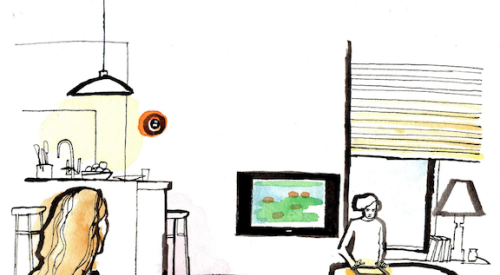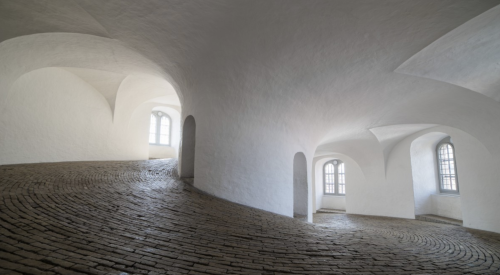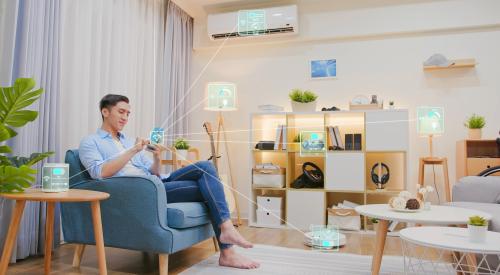Imagine having complete access to your iPod tunes and favorite satellite radio shows at the touch of a button on panels located throughout the home via a distributed audio system. Picture being able to see who is at the front door with a security camera you can view from your television or home PC. Homebuyers have unmet needs for a growing range of home automation applications, say technology experts, which represents an open frontier for builders.
Home automation uses computers to control basic home functions automatically, sometimes remotely. Home automation runs the gamut from lighting, audio-video, security systems, HVAC, water sprinklers and more. Most automated applications start with structured pre-wiring to run through the walls of the house to connect lights, telephones, speakers, and televisions to a network of computers and electronics, often located in the basement, attic or ample-sized closet.
While more than half of builders showcasing structured wiring in one or more of their homes, only about 39 percent of all new homes feature the necessary wiring to deliver home automation, according to findings by the NAHB Research Center in its 2004 Builder Practices survey.
Pre-wire first"Builders need to consider home automation. When you are pushing granite countertops, you've got to address structural pre-wiring," says Frank White, partner in StayTuned Consulting, a residential technology consulting firm in Brea, Calif. White says given consumer reliance on staying connected to e-mail, the Internet and heavy use of television among other technologies, builders have missed the mark on meeting consumer demand for automation.
At present, there are no agreed-upon industry standards and definitions of what constitutes a structured pre-wire. White, for example, suggests in addition to the basics such as regular telephone wiring and using only UL-listed cable, basic structural wiring could include two runs of Category 5 or 6 to each media-related outlet and 2 runs of RG 6 (quad variety if desired) for video. "This will enable the home to communicate within itself and to the outside world effectively," he says.
Considering costsWith smart marketing to differentiate their products from competitors, builders can come out ahead when building in various levels of home automation in their spec and production models, says John Cioe, technology consultant and general partner with Newport Custom Homes in Scottsdale, Ariz. "It costs about $2 to $3 per square foot to properly pre-wire a home for things like lighting, HDTV and motorized drape control," Cioe says, noting a pre-wire for a typical home costs about $4,000 to $6,000.
Builders need to remember retrofitting is always significantly more expensive, says Bob Woods, audio video systems designer with Appollo Systems, low-voltage systems integrator in Maple Grove, Minn. "Get as much wire in for unknown future needs. Wire is cheap. Tearing down walls and sheetrock later is expensive." With adequate pre-wiring, costs to finish an audio-video system incorporating home theater can range from anywhere from $1,000 to upwards of $150,000 on elaborate systems, Woods says.
White says on the low end of distributed audio, home theater and other audio-visual considerations — the three most popular forms of home automation, according to the leading industry trade group CEDIA (Custom Electronic Design and Installation Association) — an entry level package can start at $20,000 or less. A mid-range package goes to $75,000 including theater and media server access to music and video to upwards of $500,000 for deluxe systems, he says.
Planning and installsNo longer can installations of home automation systems be relegated to electricians or hobbyists. A plethora of firms specialize in home installation of automation systems including infrastructure wiring of new homes, home networking, integrated control systems, HVAC, lighting, etc. Experts recommend seeking out a CEDIA-member firm. "Make sure the firm you use has CEDIA-certified installers," Woods says.
Cioe generally advises builders to plan for home automation up front in the design stage by bringing in HVAC contractors to make sure networking equipment and other electronics have ample cooling and designers to honor space and aesthetic considerations. Particularly involving upper-bracket homes, Cioe says builders need to "future proof" their product. "Anyone who is buying a high-end home wants to make sure their home isn't obsolete the day they move in. There's tremendous opportunity for builders to establish themselves in this niche."
Partnering and marketing savvyBuilders who are serious about expanding their home automation offerings should form partnerships with home automation experts, including lighting and other low-voltage systems installers. "Some companies are only geared toward the end user. Talk to a CEDIA-trained firm that has a relationship serving builders," Cioe advises. The same goes for bringing in the homebuyer early in the process. "Builders need to let home technology firms work with their clients from day one," he says.
Woods advises builders new to home automation to limit their scope to a few tiers of automation packages, such as a basic pre-wire package, a moderately-priced package with audio-video basics, and a higher-end version featuring zoned lighting control systems by AMX or Creston and security features.
Lastly, Cioe advises builders to talk in terms of capabilities to customers. "The user doesn't need to know a Category 5 network cable from a 14/4 speaker cable. Tell them from this touch panel you can control lighting, air conditioning and Internet cameras for security," he says.
| Author Information |
| Marcia Jedd is a Minneapolis-based freelance writer and communications consultant. |









